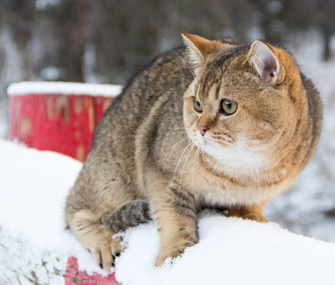How to Help Outdoor Cats Stay Warm and Safe in Winter Weather
Published on January 08, 2016
Skip To

If you have a kind heart and warm feelings for the animals who help keep down the rodent population in your neighborhood, here are three ways to help them stay warm, fed and safe during the worst winter weather.
Shelter From the Cold
Outdoor cats need a place to go when the temperatures drop. You can purchase an appropriate shelter at a pet supply store, modify a doghouse or make your own. The kind of cat house you want in your neighborhood is approximately two feet by three feet and at least 18 inches high. It’s just the right size for a cat or three (so they can snuggle for warmth) but not so large that heat will disperse quickly.Keep the doorway small, about six to eight inches wide. That will help keep larger predators out in the cold. Attaching a plastic flap will help to repel snow, rain and wind, and keep warmth inside.
Insulate the shelter with straw, not hay. Mylar blankets cut to size can also help cats retain warmth. Avoid using conventional fabric blankets or towels, which absorb moisture and can make the interior cold. Placing the shelter on a pallet or other surface to raise it off the ground can also help to insulate it.
Place shelters in out-of-the-way areas. Cats won’t use them if they’re in high-traffic areas. Think about where you’d feel safe if you were a cat and put the shelter there.
Alley Cat Allies has some great suggestions on shelters to buy or make using plastic storage containers. Building supply stores may be willing to donate scrap lumber for DIY cat shelters.
A Warm Meal (and a Drink, Too)
Outdoor cats need extra calories to help them stay warm. Put slightly warmed canned food out at regular times each day — the cat will learn
to arrive then and eat before the food gets cold. Even
if you normally give canned food, leave out plenty of dry food as well. Canned
food will freeze if it’s not eaten right away.Many cats tend to be chronically dehydrated, and winter’s chill can make it even more difficult for feral or outdoor cats to get access to water. The best thing you can do is put out water for them and check it twice daily to make sure it hasn’t frozen over. An even better option is to purchase a pet-safe, heated water dish to prevent freezing. If that’s not feasible, look for solar pet dishes that use sun power to keep water and food from freezing. Remember to refresh the water daily, so it stays clean.
Place water and food dishes near shelters but not inside them. If water spills inside the shelter, it can make it a whole lot colder. And avoid using metal bowls. You know what happens when you touch your tongue to something metal when it’s cold outside — it sticks, right? Happens to cats, too. Use ceramic or plastic dishes instead.
Safe Starts
Like I always say, knock, knock on the hood before starting your car. Outdoor cats often seek shelter in warm car engines, and they can be shredded if you start your car without checking for their presence. Bang on the hood a couple of times and honk your horn to startle any sheltering felines, and make sure they are safely out of the way before you start the engine.Watch for antifreeze drips as well. The sweet liquid is highly toxic to cats. Lapping up just a small amount, as little as a teaspoon, can kill a cat. Wipe up antifreeze spills right away to protect your own pets and any outdoor cats who may come across them.
For more ideas on how to help outdoor cats stay safe and warm, check out the tips from the folks at Neighborhood Cats and the ASPCA.
More on Vetstreet:

